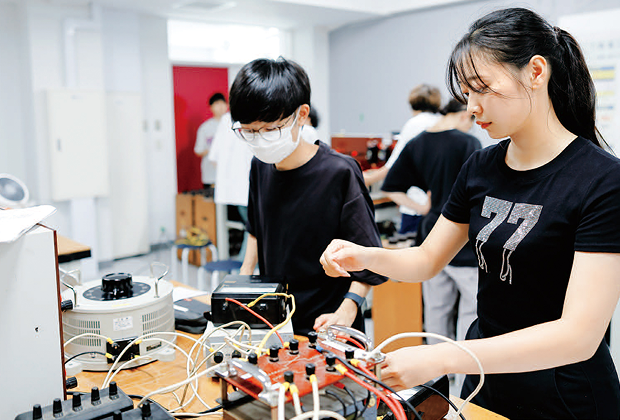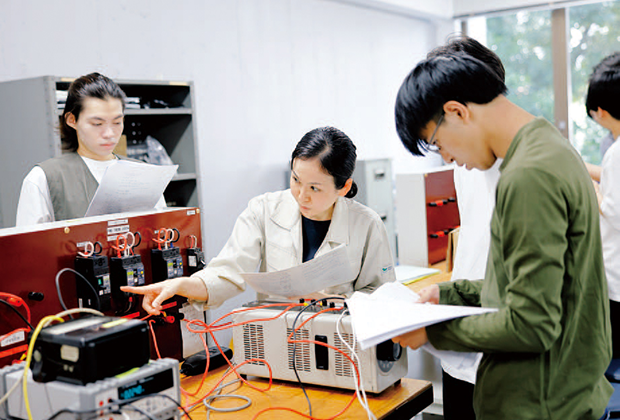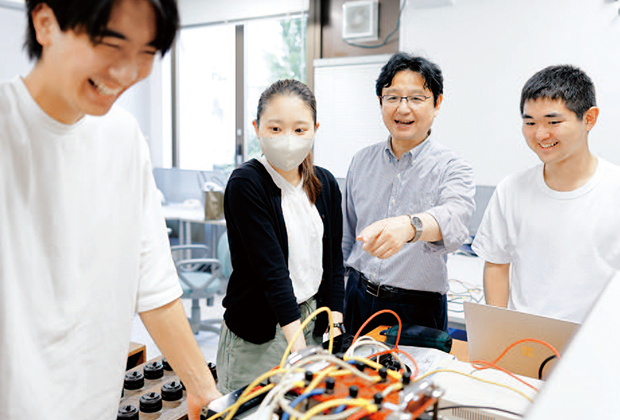-
Mechanical System Design Exercise II
(Compulsory Elective Course in the Department of Engineering and Applied Sciences)The electrical and electronic engineering course offers three semesters of experimental classes focusing on subjects that involve hardware. By performing actual experiments, students deepen their understanding, which is difficult to acquire through classroom lessons alone, such as the confirmation of basic physical laws and the operating characteristics of devices of different sizes, from semiconductor elements to power equipment. In Mechanical System Design Exercise II, students will learn the following subjects: (1) amplifier circuits using transistors, (2) basic characteristics of AC circuits, (3) semiconductor devices, (4) transformers, and (5) three- phase induction motors. While conducting experiments in groups of three to four people, students learn how to cooperate with other team members and develop a sense of responsibility such that they do not leave things to others.It is important that students carry out experiments themselves.1 : Two students are measuring the characteristics of a transformer. 2 : Three students are measuring the characteristics of a semiconductor device. instructions to groups at the experiment table. Students can ask questions on the spot. (The instructor is pointing with a finger in both photos.)
3 4 : The instructor is giving instructions to groups at the experiment table. Students can ask questions on the spot. (The instructor is pointing with a finger in both photos.) -
-
Experiments & Exercises in Physics II
(Compulsory Elective Course in the Department of Engineering and Applied Sciences)Students will conduct exercises and experiments keeping in mind the topics of lectures on physics, especially quantum mechanics and statistical mechanics. Based on the curriculum policy of the department, students will acquire a deep understanding of basic physics and mathematics, acquire knowledge that can be applied to materials, devices, energy, etc., and develop the ability to create new functions and innovative improvements to existing technologies.-
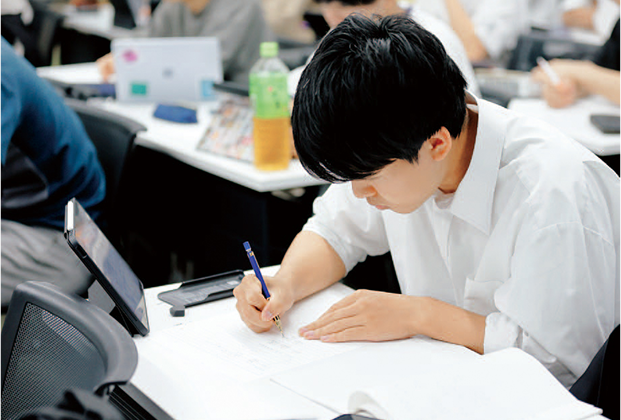 Students are working on exercises.
Students are working on exercises. -
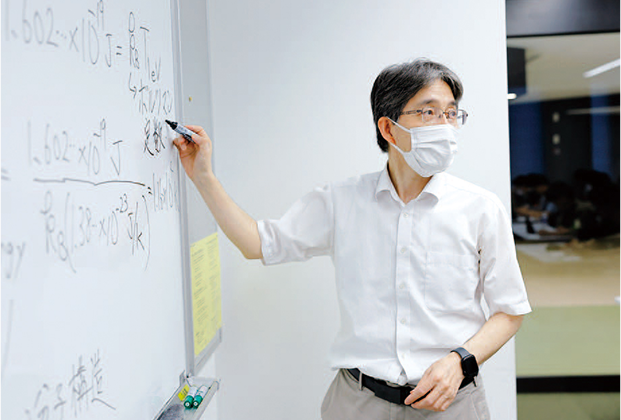 An instructor is explaining the details before starting exercises.
An instructor is explaining the details before starting exercises. -
 A teaching assistant is giving advice on how to solve exercises.
A teaching assistant is giving advice on how to solve exercises. -
 A computer is often used for solving exercises.
A computer is often used for solving exercises.
-
-
Mechanical System Design Exercise II
(Compulsory Elective Course in the Department of Engineering and Applied Sciences)This course provides third-year students with an opportunity to experience and learn design and drafting methods, which are important in the field of mechanical engineering. The targets of design include the selective compliance assembly robot arm (SCARA), gear pumps, and single-cylinder gasoline engines. Students themselves perform design calculations in accordance with the mechanics of materials, mechanical dynamics, fluid dynamics, thermodynamics, etc., which they have studied in their second year. On the basis of the results of design calculations, modeling is performed using a 3D CAD (Computer-Aided Design) system. Eventually, by creating 2D drawings from modeling data, students develop the ability to understand and describe design information necessary for production.-
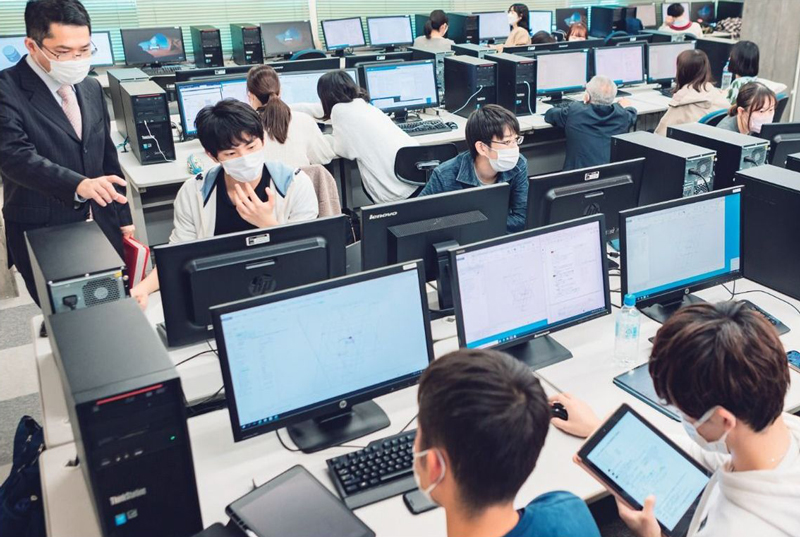 By making full use of knowledge of the mechanics of materials and thermodynamics acquired in their classes, students perform design calculations for a single-cylinder gasoline engine.
By making full use of knowledge of the mechanics of materials and thermodynamics acquired in their classes, students perform design calculations for a single-cylinder gasoline engine. -
 Modeling is performed using a 3D CAD system on the basis of the results of design calculations.
Modeling is performed using a 3D CAD system on the basis of the results of design calculations. -
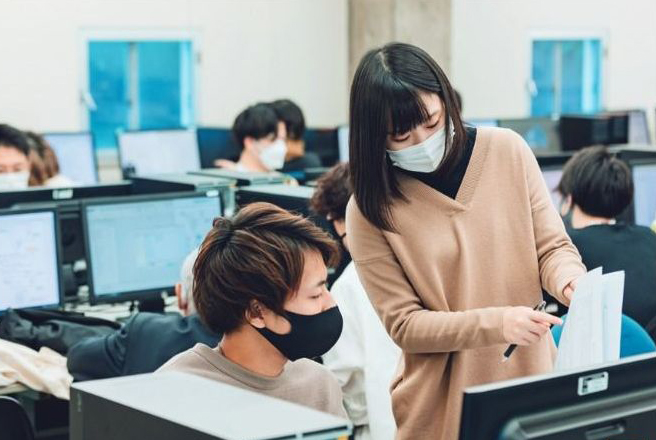 Whatever students do not understand will be kindly and politely explained by the TAs and the instructor.
Whatever students do not understand will be kindly and politely explained by the TAs and the instructor. -
 Design drawing of a piston and a connecting rod for a single-cylinder gasoline engine obtained by modeling using a 3D CAD system.
Design drawing of a piston and a connecting rod for a single-cylinder gasoline engine obtained by modeling using a 3D CAD system.
-
-
Electric Engineering Lab. I
(Compulsory Elective Course in the Department of Engineering and Applied Sciences)In this course, students will experience and learn the fundamentals of electrical and electronic engineering. This course is necessary to acquire a systematic understanding of electrical and electronic engineering and serves as the foundation for more advanced laboratory courses. Specific experimental topics are “measurement errors and their handling,” “circuit theorems,” “introduction to microcomputer control programming,” “electrostatic field,” “characteristics of magnetic materials and electromagnetic induction,” and “AC circuits and transient phenomena.” Through this course, students will learn how to perform experiments, handle equipment, process data, proceed with the investigation, and write reports. In addition, students will be able to deepen their understanding of the theories and laws learned in lectures by actual confirmation through experiments.-
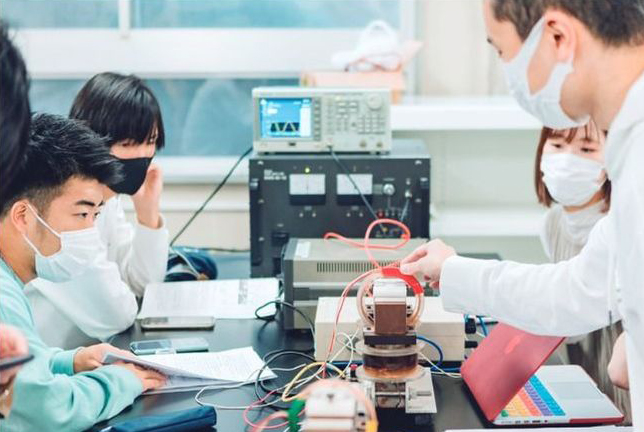 Students are conducting experiments on the “characteristics of magnetic materials and electromagnetic induction.”
Students are conducting experiments on the “characteristics of magnetic materials and electromagnetic induction.” -
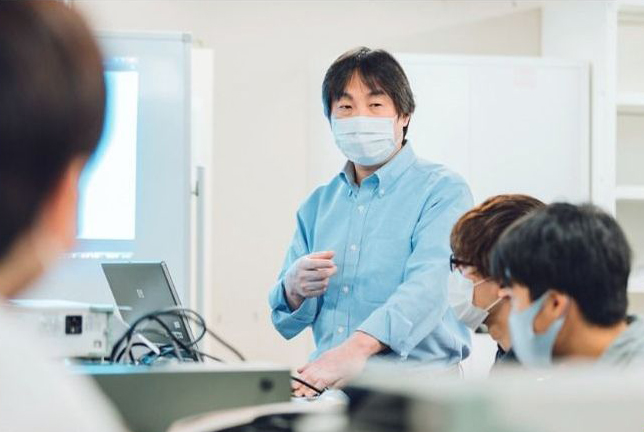 Students perform experiments while receiving guidance from the instructor.
Students perform experiments while receiving guidance from the instructor. -
 Wiring for measurement of electric circuits.
Wiring for measurement of electric circuits. -
 Generation of electrical signal waveform by a function generator.
Generation of electrical signal waveform by a function generator.
-










 Materials and Life Science
Materials and Life Science
 Engineering and Applied Sciences
Engineering and Applied Sciences
 Information and Communication Sciences
Information and Communication Sciences

